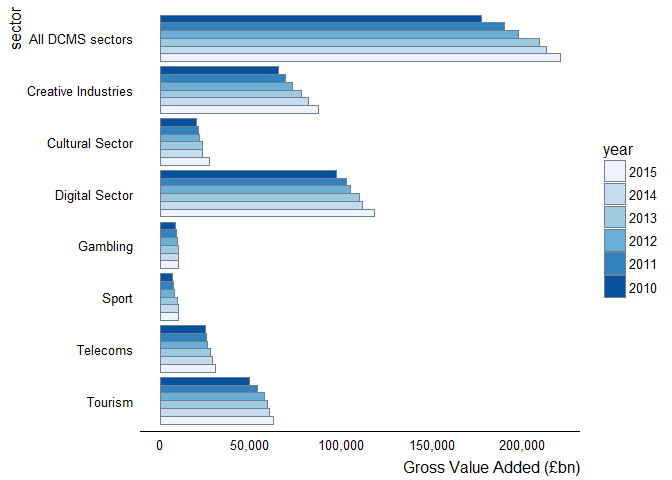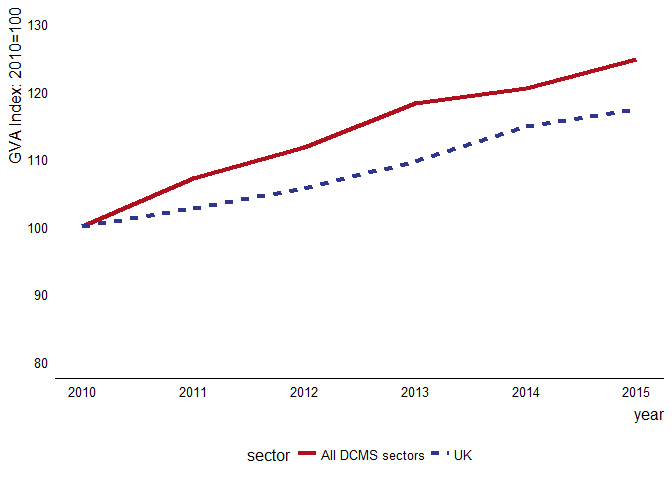First Statistical Release
This is a prototype and subject to constant development
This package provides functions used in the creation of a Reproducible Analytical Pipeline (RAP) for the Economic Estimates for DCMS sectors publication.
See the eesectorsmarkdown repository for an example of implementing these functions in the context of a Statistical First Release (SFR).
The package can then be installed using
devtools::install_github('DCMSstats/eesectors'). Some users may not be
able to use the devtools::install_github() commands as a result of
network security settings. If this is the case, eesectors can be
installed by downloading the zip of the
repository
and installing the package locally using
devtools::install_local(<path to zip file>).
This package provides functions to recreate Chapter three -- Gross Value Added (GVA) of the Economic estimates of DCMS Sectors.
The data are provided to DCMS as spreadsheets provided by the Office for National Statistics (ONS). Hence, the first set of functions in the package are designed to extract the data from these spreadsheets, and combine the data into a single dataset, ready to be checked, and converted into tables and figures.
There are four extract_ functions:
extract_ABS_dataextract_DCMS_sectorsextract_GVA_dataextract_SIC91_dataextract_tourism_data
Note: that with the exception of extract_DCMS_sectors, the data
extracted by these functions is potentially disclosive, and should
therefore be handled with care and considered to be OFFICIAL-SENSITIVE.
Steps must be taken to prevent the accidental disclosure of these
data.
These should include (but not be limited to):
- Not storing the output of these functions in git repositories
- Labelling of official data with a prefix/suffix of 'OFFICIAL'
- The use of githooks to search for potentially disclosive files at time of commit and push (e.g. https://github.com/ukgovdatascience/dotfiles)
- Suitable 2i/QA steps
The extract functions will return a data.frame, and can be called as
follows (see individual function documentation for more information
about each of the arguments).
# path to spreadsheet containing the underlying data
input <- 'working_file_YYYY.xlsm'
# eesectors has a built in example spreadsheet
input <- example_working_file("example_working_file.xlsx")
extract_ABS_data(input)
The various datasets used in the GVA chapter can be combined with the
combine_GVA() function, which will return a data.frame of the
combined data.
combine_GVA(
ABS = extract_ABS_data(input),
GVA = extract_GVA_data(input),
SIC91 = extract_SIC91_data(input),
tourism = extract_tourism_data(input)
)
The GVA chapter is built around the year_sector_data class. To create
a year_sector_data object, a data.frame must be passed to it which
contains all the data required to produce the tables and charts in
Chapter three.
An example of how this dataset will need to look is bundled with the
package: GVA_by_sector_2016. These data were extracted directly from
the 2016 SFR which is in the public domain, and provide a test case for
evaluating the data.
library(eesectors)
GVA_by_sector_2016
## # A tibble: 54 × 3
## sector year GVA
## <fctr> <int> <dbl>
## 1 creative 2010 65188
## 2 culture 2010 20291
## 3 digital 2010 97303
## 4 gambling 2010 8407
## 5 sport 2010 7016
## 6 telecoms 2010 24738
## 7 tourism 2010 49150
## 8 creative 2011 69398
## 9 culture 2011 20954
## 10 digital 2011 102966
## # ... with 44 more rows
When an object is instantiated into the year_sector_data class, a
number of checks are run on the data passed as the first argument. These
are explained in more detail in the help ?year_sector_data()
gva <- year_sector_data(GVA_by_sector_2016)
## Initiating year_sector_data class.
##
##
## Expects a data.frame with three columns: sector, year, and measure, where
## measure is one of GVA, exports, or enterprises. The data.frame should include
## historical data, which is used for checks on the quality of this year's data,
## and for producing tables and plots. More information on the format expected by
## this class is given by ?year_sector_data().
##
## *** Running integrity checks on input dataframe (x):
##
## Checking input is properly formatted...
## Checking x is a data.frame...
## Checking x has correct columns...
## Checking x contains a year column...
## Checking x contains a sector column...
## Checking x does not contain missing values...
## Checking for the correct number of rows...
## ...passed
##
## ***Running statistical checks on input dataframe (x)...
##
## These tests are implemented using the package assertr see:
## https://cran.r-project.org/web/packages/assertr for more details.
## Checking years in a sensible range (2000:2020)...
## Checking sectors are correct...
## Checking for outliers (x_i > median(x) + 3 * mad(x)) in each sector timeseries...
## Checking sector timeseries: all_dcms
## Checking sector timeseries: creative
## Checking sector timeseries: culture
## Checking sector timeseries: digital
## Checking sector timeseries: gambling
## Checking sector timeseries: sport
## Checking sector timeseries: telecoms
## Checking sector timeseries: tourism
## Checking sector timeseries: UK
## ...passed
## Checking for outliers on a row by row basis using mahalanobis distance...
## Checking sector timeseries: all_dcms
## Checking sector timeseries: creative
## Checking sector timeseries: culture
## Checking sector timeseries: digital
## Checking sector timeseries: gambling
## Checking sector timeseries: sport
## Checking sector timeseries: telecoms
## Checking sector timeseries: tourism
## Checking sector timeseries: UK
## ...passed
Any failed checks are raised as warnings, not errors, and so the user is
able to continue. However it is also possible to log these warnings as
github issues by setting log_issues=TRUE. This is a prototype feature
that needs additional work to increase the usefulness of these issues,
see below for details on environmental variables that are required for
this functionality to work.
Tables and charts for Chapter three can be reproduced simply by running the relevant functions:
year_sector_table(gva)
## # A tibble: 10 × 10
## sector X2010 X2011 X2012 X2013 X2014 X2015
## <fctr> <chr> <chr> <chr> <chr> <chr> <chr>
## 1 Creative Industries 65.2 69.4 73.0 77.9 81.6 87.3
## 2 Cultural Sector 20.3 21.0 21.8 23.5 23.5 27.0
## 3 Digital Sector 97.3 103.0 105.2 110.0 111.6 118.4
## 4 Gambling 8.4 9.3 9.8 9.9 10.2 10.3
## 5 Sport 7.0 7.4 7.9 9.8 10.3 10.1
## 6 Telecoms 24.7 25.4 26.0 28.0 29.1 30.2
## 7 Tourism 49.1 53.9 57.3 59.0 60.4 62.4
## 8 All DCMS sectors 177.1 189.8 197.9 209.4 213.3 220.9
## 9 % of UK GVA 12.5 13.1 13.2 13.5 13.1 13.3
## 10 UK 1414.6 1452.1 1495.6 1551.6 1624.3 1661.1
## # ... with 3 more variables: since_2014 <dbl>, since_2010 <dbl>,
## # UK_perc <dbl>
figure3.1(gva)
Note that figures produced remain ggplot2 objects, and can therefore
be edited in the following way:
p <- figure3.2(gva)
p
Titles, and other layers can then be added simply:
library(ggplot2)
p + ggtitle('Figure 3.2: Indexed growth in GVA (2010 =100)\n in DCMS sectors and UK: 2010-2015')
Note that figures make use of the govstyle package. See the vignette for more information on how to use this package.



